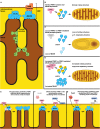Potential Role of Mic60/Mitofilin in Parkinson's Disease
- PMID: 30740041
- PMCID: PMC6357844
- DOI: 10.3389/fnins.2018.00898
Potential Role of Mic60/Mitofilin in Parkinson's Disease
Abstract
There are currently no treatments that hinder or halt the inexorable progression of Parkinson's disease (PD). While the etiology of PD remains elusive, evidence suggests that early dysfunction of mitochondrial respiration and homeostasis play a major role in PD pathogenesis. The mitochondrial structural protein Mic60, also known as mitofilin, is critical for maintaining mitochondrial architecture and function. Loss of Mic60 is associated with detrimental effects on mitochondrial homeostasis. Growing evidence now implicates Mic60 in the pathogenesis of PD. In this review, we discuss the data supporting a role of Mic60 and mitochondrial dysfunction in PD. We will also consider the potential of Mic60 as a therapeutic target for treating neurological disorders.
Keywords: Mic60/mitofilin; Parkinson’s disease; mitochondria; mitochondrial dynamics; neurodegeneration.
Figures

Similar articles
-
Mic60/mitofilin overexpression alters mitochondrial dynamics and attenuates vulnerability of dopaminergic cells to dopamine and rotenone.Neurobiol Dis. 2016 Jul;91:247-61. doi: 10.1016/j.nbd.2016.03.015. Epub 2016 Mar 19. Neurobiol Dis. 2016. PMID: 27001148 Free PMC article.
-
PINK1 Phosphorylates MIC60/Mitofilin to Control Structural Plasticity of Mitochondrial Crista Junctions.Mol Cell. 2018 Mar 1;69(5):744-756.e6. doi: 10.1016/j.molcel.2018.01.026. Epub 2018 Feb 15. Mol Cell. 2018. PMID: 29456190
-
Parkin interacts with Mitofilin to increase dopaminergic neuron death in response to Parkinson's disease-related stressors.Am J Transl Res. 2020 Nov 15;12(11):7542-7564. eCollection 2020. Am J Transl Res. 2020. PMID: 33312388 Free PMC article.
-
Mitochondrial inner membrane protein, Mic60/mitofilin in mammalian organ protection.J Cell Physiol. 2019 Apr;234(4):3383-3393. doi: 10.1002/jcp.27314. Epub 2018 Sep 14. J Cell Physiol. 2019. PMID: 30259514 Free PMC article. Review.
-
Current perspective of mitochondrial biology in Parkinson's disease.Neurochem Int. 2018 Jul;117:91-113. doi: 10.1016/j.neuint.2018.03.001. Epub 2018 Mar 14. Neurochem Int. 2018. PMID: 29550604 Free PMC article. Review.
Cited by
-
Multi-omics and experimental analysis unveil theragnostic value and immunological roles of inner membrane mitochondrial protein (IMMT) in breast cancer.J Transl Med. 2023 Mar 10;21(1):189. doi: 10.1186/s12967-023-04035-4. J Transl Med. 2023. PMID: 36899366 Free PMC article.
-
Mitochondrial compartmentalization: emerging themes in structure and function.Trends Biochem Sci. 2021 Nov;46(11):902-917. doi: 10.1016/j.tibs.2021.06.003. Epub 2021 Jul 7. Trends Biochem Sci. 2021. PMID: 34244035 Free PMC article. Review.
-
Increased expression of heme-binding protein 1 early in Alzheimer's disease is linked to neurotoxicity.Elife. 2019 Aug 27;8:e47498. doi: 10.7554/eLife.47498. Elife. 2019. PMID: 31453805 Free PMC article.
-
Ancestral sequence reconstruction of the Mic60 Mitofilin domain reveals residues supporting respiration in yeast.Protein Sci. 2025 Jul;34(7):e70207. doi: 10.1002/pro.70207. Protein Sci. 2025. PMID: 40545685 Free PMC article.
-
Suppressing mitochondrial inner membrane protein (IMMT) inhibits the proliferation of breast cancer cells through mitochondrial remodeling and metabolic regulation.Sci Rep. 2024 Jun 4;14(1):12766. doi: 10.1038/s41598-024-63427-8. Sci Rep. 2024. PMID: 38834715 Free PMC article.
References
Publication types
LinkOut - more resources
Full Text Sources

